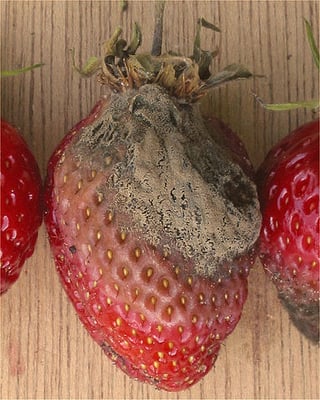Controlling Grey Mould in the Greenhouse
Written by John Harrison on 24th Aug 2015.

Grey mould, properly called botrytis, is caused by the common fungus Botrytis cinerea, and presents as a furry grey mould. As the season comes to an end and the nights grow cooler, the atmosphere in the greenhouse becomes more humid which encourages fungal growths like botrytis but it can be a problem at any time of the year.
It commonly starts by growing on dead leaves or rotting fruit and once it produces spores, increasing the density of spores in the greenhouse to the point where even healthy plants are at risk.
Split tomatoes and leaves on plants damaged, perhaps by aphids or slugs, will then start growing the mould. Once established it spreads quickly and you will see plants dying and the leaves letting off smoke-like clouds of spores when disturbed.
Keys to Controlling Grey Mould
The keys to controlling grey mould are vigilance, prompt action and good hygiene. Be alert to the problem, especially when the air is humid and take a minute to look for any signs of grey mould daily.
Promptly remove any yellowing or dead leaves from the plants as well as any showing signs of infection. Dispose of any dropped fruits immediately before they start to develop mould. Do not leave any dead plant material lying around to develop the mould.
In the greenhouse the plants most likely to be affected by grey mould are:
- Tomatoes
- Cucumbers
- Courgettes
- Grapes
- Strawberries
- Ornamental Plants
- Avoid Overcrowding
Overcrowding is a factor in botrytis infections. Leaving air spaces between plants will help reduce and avoid the problem. Consider thinning tomato foliage but remember the damage of removing leaves in itself makes the plant vulnerable.
Reduce HumidityReducing humidity by increasing ventilation or even by shutting the vents and running a dehumidifier will help slow the development of the disease if not stop it completely.
If there is a growing border, insert a 2 litre drink bottle with the base cut off top-down or a funnel or pipe, into the soil by each plant. Water via this which will keep the soil surface dry so reducing humidity.
Sprays for Grey Mould
There are no specific chemical controls for grey mould available to the gardener. Some have reported a measure of success spraying with Vitax Organic 2 in 1 which contains fish oils although there is no recommendation for this problem by the manufacturer.
A spray of skimmed milk, diluted 1 part milk to 4 parts water, has been shown to be useful for powdery mildew and may have some effect on botrytis. Another mildew remedy that may help is bicarbonate of soda mixed with soft soap as a sticking agent and sprayed on.
Copyright © John Harrison 2015